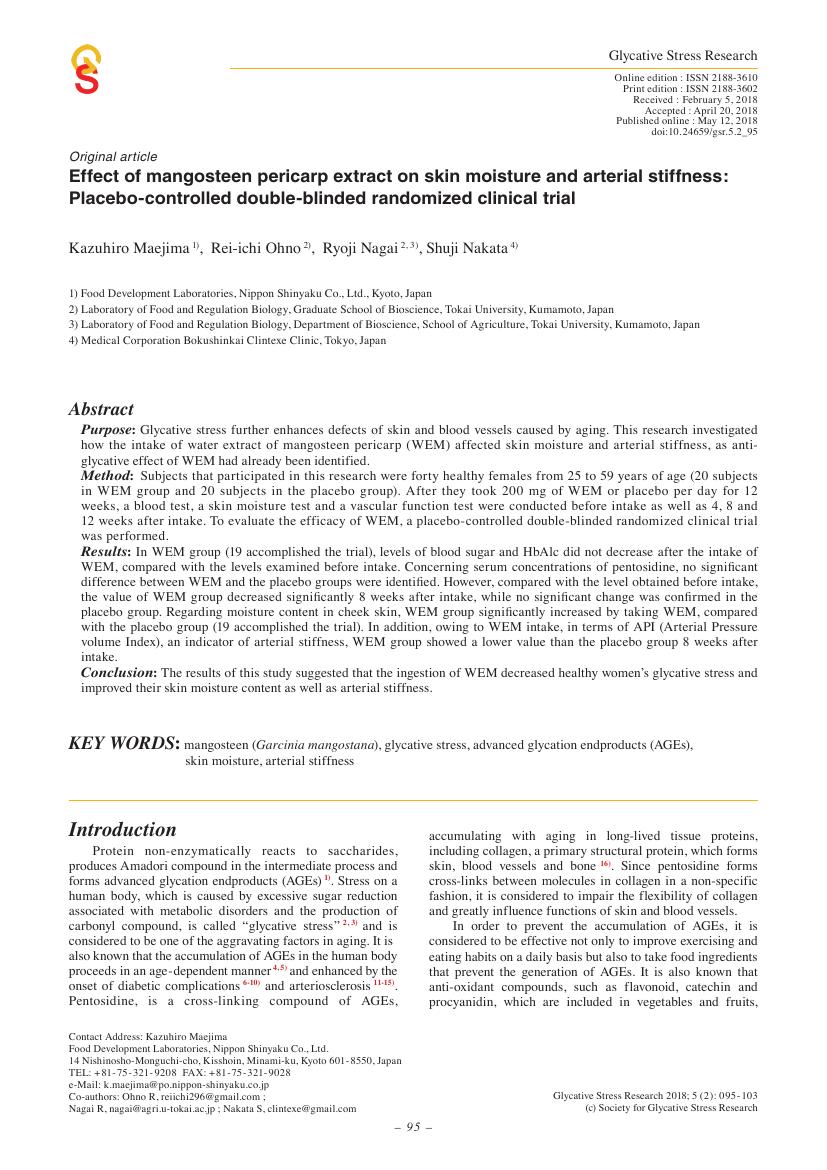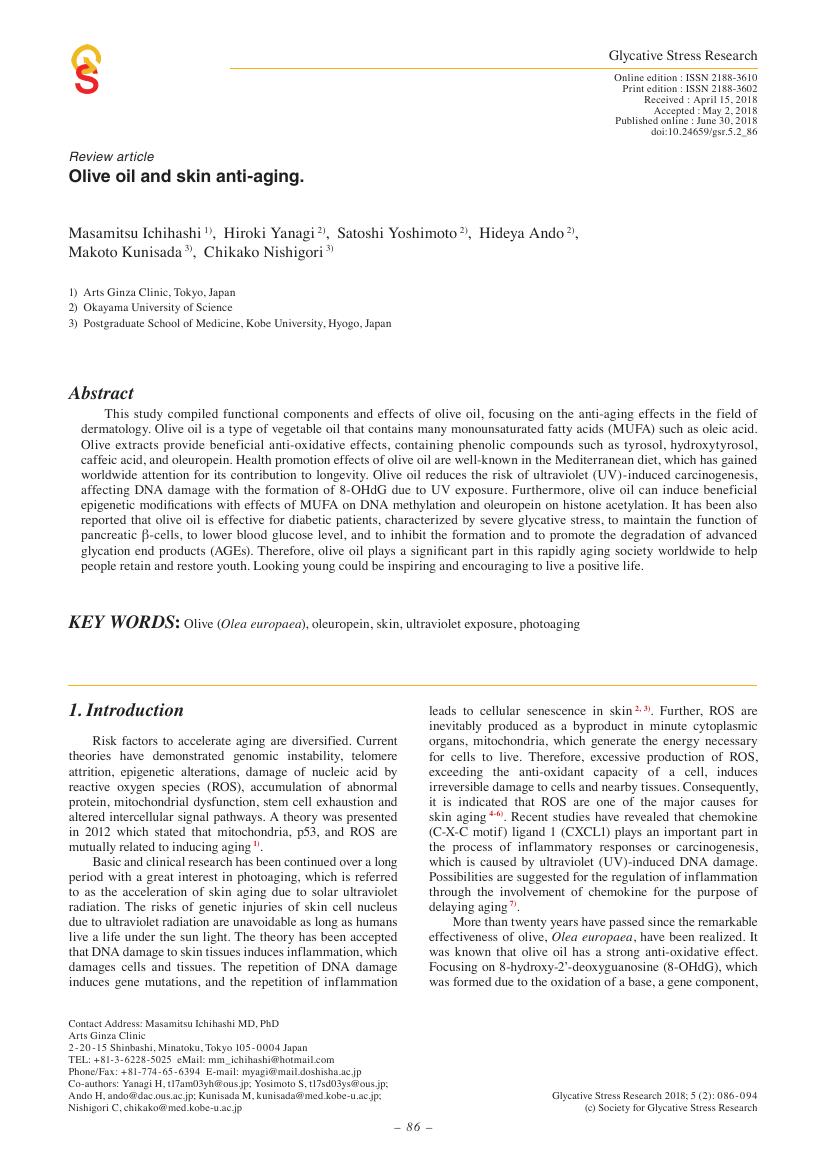- 著者
- Akane Tsuruta Tian Zheng Mari Ogura Masayuki Yagi Wakako Takabe Yoshikazu Yonei
- 出版者
- Society for Glycative Stress Research
- 雑誌
- Glycative Stress Research (ISSN:21883602)
- 巻号頁・発行日
- vol.6, no.1, pp.39-48, 2019 (Released:2019-05-31)
9 0 0 0 OA 糖化ストレスとアンチエイジング 7.糖化ストレスと皮膚老化
- 出版者
- Society for Glycative Stress Research
- 雑誌
- Glycative Stress Research (ISSN:21883602)
- 巻号頁・発行日
- vol.5, no.1, pp.50-54, 2018 (Released:2018-08-10)
- 著者
- Michiya Igase Yoshikazu Yonei Shigeru Matsumi Akihiko Shimode Tetsuya Maruyama Keiji Igase Maya Ohara Yoko Okada Masayuki Ochi Sayaka Matsumoto Yasumasa Ohyagi
- 出版者
- Society for Glycative Stress Research
- 雑誌
- Glycative Stress Research (ISSN:21883602)
- 巻号頁・発行日
- vol.6, no.2, pp.75-81, 2019 (Released:2019-07-26)
- 著者
- Tsuyoshi Takara Kazuo Yamamoto Naoko Suzuki Shin-ichiro Iio Hayata Noguchi Toshihiro Kakinuma Asami Baba Wakana Yamada Masafumi Nagata Hiroshi Shimoda
- 出版者
- Society for Glycative Stress Research
- 雑誌
- Glycative Stress Research (ISSN:21883602)
- 巻号頁・発行日
- vol.9, no.3, pp.158-169, 2022-10-20 (Released:2022-10-26)
- 参考文献数
- 52
Background and objective: Plant-derived glucosylceramides (GlcCer) have been clinically reported to enhance skin barrier functions. GlcCer and ceramides (Cer) interact with immune-stimulating receptors on antigen-presenting cells, such as c-type lectin receptors and toll-like receptor 4. However, the clinical and immunological efficacies of orally ingested GlcCer remain unknown. Therefore, we herein conducted a clinical trial on the effects of rice-derived GlcCer (Oryza Ceramide®: OC) on cold symptoms, immune parameters, and SF-36 scores. Methods: OC (type PCD, 60 mg daily) containing 1.8 mg of GlcCer and 0.09 mg of Cer [t18:0/24:0] was used as the active sample. We enrolled 44 healthy Japanese individuals who are prone to catching colds and a low immune score. All subjects were randomly allocated to an active group (n = 22) or placebo group (n = 22). Capsules containing OC or the placebo were administered for 8 weeks. Cold symptom scores during the intervention were the primary outcome, while immune parameters and SF-36 scores measured after the 8-week intervention were the secondary outcomes. Results: Forty subjects completed the trial, and the per protocol set comprised 19 and 21 in the active and placebo groups, respectively. Regarding the primary outcome, cumulative days with cold symptoms, such as nasal congestion, throat irritation, a cough, headache, muscle pain, and diarrhea, was lower in the OC group. Among the secondary outcomes, physical functioning in SF-36 scores was improved in the OC group. Regarding immune parameters, a negative correlation was observed between changes in blood T-lymphocytes and cumulative days with cold symptoms. Laboratory tests revealed no abnormalities to suggest adverse effects of OC. Conclusions: OC consisting of GlcCer attenuated typical cold symptoms, such as nasal congestion, throat irritation, a cough, headache, muscle pain, and diarrhea, and improved physical conditions. Changes in T-lymphocytes may be one of the mechanisms by which OC ameliorates cold symptoms.
- 著者
- Kyle Haasbroek Masayuki Yagi Yoshikazu Yonei
- 出版者
- Society for Glycative Stress Research
- 雑誌
- Glycative Stress Research (ISSN:21883602)
- 巻号頁・発行日
- vol.7, no.3, pp.232-239, 2020 (Released:2020-10-20)
- 参考文献数
- 64
People with Diabetes show an increased susceptibility to infection by SARS-CoV-2, greater incidence of pneumonia, and worse clinical outcomes. As diabetes involves high glycative stress, here we present a review of the literature regarding the potential interactions of glycative stress and COVID-19 that may help to explain some of the observed differences in outcomes of diabetic patients. Glycative stress directly suppresses immune function, leaving the body less able to deal with infection. Increased colonization of potentially pathogenic bacteria, mediated by glycative stress, such as Staphylococcus aureus, may also lead to negative outcomes during infection. The presence of S. aureus on the skin may weaken its barrier function and increase the risk of infection through the skin. Proteolytic activity necessary for the virus to enter cells may be enhanced in tissue exposed to S. aureus as well as by the bacteria’s own secreted proteases. Finally, S. aureus carriage could be a risk factor for the development of secondary bacterial pneumonia during primary COVID-19 infection. In order to avoid infection and severe disease outcomes, it is important for those suspected of having diabetes to maintain strict glycemic control and take measures to avoid exposure to the virus.
- 著者
- Mari Ogura Yuji Morita Wakako Takabe Masayuki Yagi Fuka Okuda Misato Kon Kenichi Asada Tetsuro Urata Hiroshi Yatou Hiroomi Maeda Yoshikazu Yonei
- 出版者
- Society for Glycative Stress Research
- 雑誌
- Glycative Stress Research (ISSN:21883602)
- 巻号頁・発行日
- vol.7, no.1, pp.29-41, 2020 (Released:2020-05-08)
- 参考文献数
- 31
Objective: We investigated the effects of the intake of ostrich meat (OM), which is characterized by high protein and low fat, on the body, focusing on protein and amino acid metabolism and growth hormone (GH) secretion. Methods: Plasma amino acid levels, growth hormone (GH) secretion after exercise and autonomic nervous function (device used: VM500 [Fatigue Science Laboratory Inc.]) were measured in 12 healthy subjects (33.3 ± 6.9 years old, BMI 21.6 ± 1.6) after ingestion of the test food (OM) or control food for one week each. Results: A significant increase in the blood levels of branched-chain amino acids (BCAAs), lysine and histidine, and an increase in those for 1-methylhistidine and 3-methylhistidine, which are the indicators of muscle protein breakdown, were observed after the intake of OM, suggesting that protein metabolism in the muscles was activated. Subclass analysis excluding cases with high GH before exercise load showed a significant increase in GH secretion after a walking exercise (30 min) only after the intake of OM. The autonomic nervous function test did not reveal any significant findings. There were no OM-related adverse events during the study. Conclusion: OM is a low-fat meat containing physiologically significant amino acids in large quantities, and it was suggested that OM could be safe and suitable for a protein and amino acid supplement.
- 出版者
- Society for Glycative Stress Research
- 雑誌
- Glycative Stress Research (ISSN:21883602)
- 巻号頁・発行日
- vol.2, no.4, pp.204-207, 2015 (Released:2018-04-30)
- 出版者
- Society for Glycative Stress Research
- 雑誌
- Glycative Stress Research (ISSN:21883602)
- 巻号頁・発行日
- vol.3, no.3, pp.133-140, 2016 (Released:2018-04-30)
- 著者
- Tetsuya Konishi Kenichi Watanabe Somasundaram Arummugam Misato Sakurai Shinji Sato Seiichi Matsugoh Tetsuo Watanabe Koji Wakame
- 出版者
- Society for Glycative Stress Research
- 雑誌
- Glycative Stress Research (ISSN:21883602)
- 巻号頁・発行日
- vol.6, no.4, pp.248-257, 2019 (Released:2020-03-03)
- 著者
- Yuji Morita Hiromi Izawa Atsuyuki Hirano Eriko Mayumi Seigo Isozaki Yoshikazu Yonei
- 出版者
- Society for Glycative Stress Research
- 雑誌
- Glycative Stress Research (ISSN:21883602)
- 巻号頁・発行日
- vol.9, no.2, pp.33-41, 2022-06-30 (Released:2022-07-17)
- 参考文献数
- 33
Purpose: The "NAD World" (proposed by Professor Shin-Ichiro Imai of the University of Washington), in which the control of aging, lifespan, and metabolism is systemically integrated through NAD (nicotinamide adenine dinucleotide), has attracted worldwide attention and is being studied from various angles, however, there are few reports of clinical studies in humans. In this study, we investigate the changes in various biomarkers in humans after oral intake of nicotinamide mononucleotide (NMN), a precursor of NAD, and evaluate its clinical significance. Methods: Based on the approval to start the study at the ethics review, 17 postmenopausal women (mean age 55.0 years) without underlying diseases who agreed to participate in the study were subjects and received oral intake of 300 mg/day of pure NMN for eight weeks. The examination items included body measurements, basal metabolic rate, blood pressure, grip strength, glycation level (AF value), blood biochemical tests, various hormones, blood SIRT1 mRNA expression and NMN, NAD and NAM levels, immunological tests (aging, T cell subset including exhausted cells), and skin VAS (visual analog scale). Results were statistically analyzed and compared at zero and eight weeks (blood biochemistry tests were performed at four weeks to confirm safety). In addition, we asked the patients to keep a diary during the course of the study to monitor their NMN intake, their bodily sensation, and side effects. Results: One of the 17 subjects dropped out at the end of four weeks due to persistent mild headache. The results showed significant changes in NAM (nicotinamide/vitamin B3) from 45.2 to 164.7 (p < 0.001), adiponectin from 13.6 to 16.2 (p = 0.004), and skin VAS score (6/7 items, p < 0.001 to = 0.001) before and after intake. Significant differences were also observed for BMI, AF levels, platelets, HbA1c, HDL-C, amylase, DHEA-s, NAD, and narrowly defined regulatory T cells (p < 0.05 above). In addition, all subjects showed a positive bodily sensation with skin, sleep, and fatigue. There were no problems with subjective symptoms or laboratory data in the 16 who completed the study. Conclusion: NMN 300 mg/day orally for eight weeks showed no safety issues and favorable changes in many biomarkers, suggesting that NMN, a member of the NAD world, may be a promising nutritional material for aging and metabolic control in humans.
- 出版者
- Society for Glycative Stress Research
- 雑誌
- Glycative Stress Research (ISSN:21883602)
- 巻号頁・発行日
- vol.4, no.2, pp.117-123, 2017 (Released:2018-04-30)
1 0 0 0 OA Fasting therapy, a medicine for human rescue: Live a life with fasting, yoga and brown rice.
- 著者
- Eiichi Sekizuka Daisuke Sekizuka Tian Zheng
- 出版者
- Society for Glycative Stress Research
- 雑誌
- Glycative Stress Research (ISSN:21883602)
- 巻号頁・発行日
- vol.5, no.4, pp.181-191, 2018 (Released:2019-03-15)
- 出版者
- Society for Glycative Stress Research
- 雑誌
- Glycative Stress Research (ISSN:21883602)
- 巻号頁・発行日
- vol.5, no.2, pp.95-103, 2018 (Released:2018-08-10)
1 0 0 0 OA オリーブオイルと皮膚のアンチエイジング
- 出版者
- Society for Glycative Stress Research
- 雑誌
- Glycative Stress Research (ISSN:21883602)
- 巻号頁・発行日
- vol.5, no.2, pp.86-94, 2018 (Released:2018-08-10)









